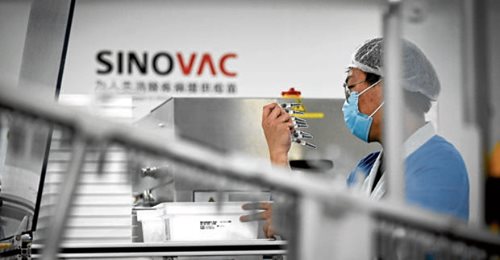
CEBU CITY, Philippines — The vaccine that will most likely reach Cebu first by March 2021 would be Sinovac.
This was the revelation of the Department of Health in Central Visayas (DOH-7) in the Regional Development Council in Central Visayas (RDC-7) for the projection of the first arriving vaccines in Cebu.
Dr. Van Philip Baton of the DOH-7 said that according to the national government, Sinovac would most likely arrive earlier than Pfizer and AstraZeneca, which would essentially adjust the priorities for the vaccination program.
Read: Duterte to personally witness arrival of Sinovac vaccines on Feb. 28 — Palace
The Pfizer vaccines may arrive later due to some issues on the enmity clause that the national government wants to address first.
Baton explained that Sinovac is not recommended to be inoculated to medical frontliners because its efficacy rate of 50 percent might still place these medical professionals, with high exposure to the virus, in danger of contracting the coronavirus disease 2019 (COVID-19).
The Food and Drug Administration (FDA) has given Sinovac, Pfizer, and AstraZeneca Emergency Use Authorizations (EUAs), but it has specified that Pfizer is highly recommended to be inoculated to health care workers because of its 94 percent efficacy.
Read: LIST: Priority groups for government’s Covid-19 vaccination program
Sinovac, on the other hand, maybe given to the next priority groups composed of non-medical frontliners and senior citizens because they are not directly exposed to the virus.
“Sinovac is quite clear that they will be arriving by March. However, the volume is not quite clear so we may have to select the population,” said Baton.
He added that Sinovac would be easier to store at only +2 to +8 degrees Celsius and would come in pre-filled syringes, which will be easier to inoculate compared to the Pfizer vaccines. This vaccine is better for mass inoculations.
Read: Sinovac vaccine OK for health workers not treating Covid-19 patients – FDA
Baton said that should Sinovac arrive first, there may be changes on who would be inoculated as the government can choose to not inoculate the medical frontliners with Sinovac and instead, choose to inoculate other groups.
It can be noted that in the first priority group A, the medical frontliners are first along with senior citizens, people with comorbidities, non-medical frontliners, and indigent population.
However, the medical workers may have to wait for Pfizer, because the FDA recommended this vaccine to keep them safe from COVID-19 infection more effectively than Sinovac.
“We will use the priority groups, we will also use the geographic locations depending on the high burden areas. Lastly, there may be further priorities if the vaccines will really be limited,” said Baton.
The senior citizens, uniformed personnel such as the police and soldiers, and people with comorbidities may be the first to be vaccinated should Sinovac arrive in Cebu if the government refuses to inoculate health workers with this China-made vaccine.
For the priorities in the medical frontliners group, the priority to be innoculated would be COVID-19 referral hospitals, hospitals catering to COVID-19 patients, other COVID-19 facilities such as isolation centers, and the remaining hospitals and other health care facilities.
Read: VSMMC healthcare workers to receive COVID vaccines from Pfizer
There are also ways that the vaccination may be deferred in the case of positive patients as they will have to wait 90 days before getting innoculated and pregnant women must wait for at least the second semester of gestation.
Priority B groups include other frontline workers and special populations.
Baton said the DOH-7 was working with all local government units (LGU) regarding the vaccination program as the LGU were responsible for establishing the Vaccine Operation Center (VOC), masterlisting the eligible groups, microplanning, mapping of vaccination sites, preparations, logistics, and information dissemination.
The region needs at least 4,000 teams of vaccinators made up of six vaccinators, with each team handling at least 100 patients per shift.
For now, DOH-7 said that the region could only wait for the vaccines while preparing all logistical possibilities for their arrival.
/dbs
Read: DOH7: COVID-19 vaccine ‘ideally works’ in preventing severe symptoms